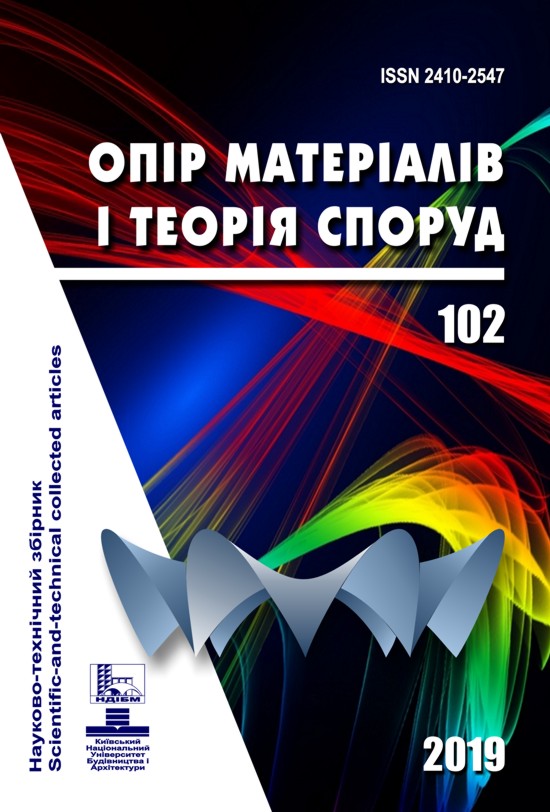Features of the numerical simulation in research on the stress strain behavior of underground structures
DOI:
https://doi.org/10.32347/2410-2547.2019.102.139-149Keywords:
underground structures, finite element method, loads from soil mass, material model of soil, fe-mesh dimensionsAbstract
In our time, widely use numerical calculations methods, the leading place among which is the finite element method (FEM).
The necessity of using numerical methods in calculating underground structures is caused by complexity and the inability to perform analytical calculation because of such factors: сomposite build configuration, structural diagram of constructions, anisotropy of materials, differential subsidence, multistage construction, etc.
The article considers the most common questions, which arise at the stage of discrete modelling for calculation of the stress strain behavior of system "underground development - a soil mass" by use of FEM, such as:
Measuring and pattern of distribution dead loads from soil mass. At great depth underground pressure generally does not depend on depth of construction, that give a problem.
Choosing a material model. The credibility of research results depends on selected mathematical model of the soil. Simple models give blunder and complex models require more conditions that need to be determined qualitatively using special purpose equipment.
Choosing FE-mesh dimensions. Differing approaches to problem solving impact differently on the distribution of stress strain behavior in constructions and the soil mass.
Also, the article deals questions of dimensioning mesh coarseness, selecting boundary conditions, the setting of interfaces, etc.
Problem solution requires a thorough understanding of the mathematical methods and the physical phenomena that are modelled, taking into account the diversity of natural and production factors.
References
Borshch-Komponiets V.I. Prakticheskaia mekhanika hornykh porod (Practical mechanics of rocks) – Moskva: Hornaia kniha, 2013. – 322 p.
Ehorov P.V.Heomekhanika (Geomechanics) / P. V.Ehorov, H. H. Shtumpf, A. A. Renevtain. – Kemerovo: Kemvuzizdat, 2001. – 276 p.
Petrenko V.D. Obzor analiticheskikh i eksperimentalnykh metodov issledovaniia vzaimodeistviia massiva i krepi (An overview of analytical and experimental methods for studying the interaction of the array and the support) / V.D. Petrenko, A.L. Tiutkin, V.I. Petrenko. // Mosti ta tuneli: teoriia, doslidzhennia, praktika. – 2012. – №1. – P. 75–81.
Solodei I.I. Viznachennia navantazhen vid masivu hruntovikh sipuchikh porid pri proektuvanni pidzemnikh sporud (Determination of loads from array of runningsoil when designing underground structures)/ I.I. Solodei, H.A. Zatiliuk. // Opir materialiv i teoriia sporud. – 2016. – №97. – P. 145–154.
Danh Van Chyonh. Izmenenie napriazhenno-deformirovannoho sostoianiia sistemy «hruntovyi massiv – tonnel» v zavisimosti ot hlubiny zalozheniia tonnelia (Change in the stress-strain state of the system "soilmassif - tunnel" depending on the depth of the tunnel)/ Danh Van Chyonh // Vestnik MADI. – 2015. – vyp. 4 (43). – P. 89-94
Kudasheva M.I. Sravnenie modeli Mora-Kulona i modeli uprochniaiushchehosia hrunta v prohrammnom komplekse Plaxis [Elektronniiresurs] (Comparison of the Mora-Coulomb model and the hardening soil model in the Plaxis software package)/ M.I. Kudasheva, S.V. Kaloshina // Stroitelstvo i arkhitektura. Opyt i sovremennye tekhnolohii. – 2017. – http://sbornikstf.pstu.ru/council/?n=9.
Yudina I.M. K voprosu o vybore raschetnoi modeli dlia prohnozirovaniia napriazhenno-deformirovannoho sostoianiia hruntov pri ustroistve kotlovanov (On the issue of choosing a computational model for predicting the stress-strain state of soils during the construction of trenches) / I.M. Yudina, A.N. Klimov. //Vestnik MHSU. – 2008. – №2. – P. 145–149.
Strokova L.A. Opredelenie parametrov dlia chislennoho modelirovaniia povedeniia hruntov (Determination of parameters for numerical simulation of soil behavior) / L.A. Strokova // Izvestiia Tomskoho politekhnicheskoho universiteta. – 2008. – №1. – P. 69–74.
Bezghodov M.A. Vybor modeli hrunta pri chislennom modelirovanii vliianiia razrabotki hlubokikh kotlovanov na sushchestvuiushchuiu zastroiku (Choosing a soil model for numerical simulation of the influence of deep excavation on the existing building) / M.A. Bezghodov, S.V. Kaloshina. // Vestnik PNIPU. Urbanistika. - 2012. - № 2(6). - P. 17-27.
Holubev A.I. Vyibor modeli grunta i eyo parametrov v raschyotah geotehnicheskih ob'ektov (The choice of soil model and its parameters in the calculation of geotechnical objects) / A.I. Holubev A.V. Seletskii // Trudy mezhdunarodnoi konferentsii po heotekhnike "Heotekhnicheskie problemy mehapolisov (GEOMOS 2010). – 2010. – tom 4. – P. 1727-1732.
Berezhnoi D.V. Modelirovanie deformirovaniia obdelki tonnelia metropolitena, raspolozhennoi v hrunte slozhnoi fizicheskoi prirody (Modeling the deformation of the lining of the tunnel of the subway, located in the ground of a complex physical nature) / D.V. Berezhnoi, M.K. Sahdatullin, L.U. Sultanov. // Vestnik Kazanskoho tekhnolohicheskoho universiteta. – 2013. – №9. – P. 250–255.
Petrov D.N. Chislennoe modelirovanie napriazhennoho sostoianiia v obdelke kolonnykh stantsii bez bokovykh platform (Numerical modeling of the stress state in the lining of columnar stations without sideplatforms)/ D.N. Petrov, P.A. Demenkov, D.A. Potemkin. // Zapiski Hornoho instituta. – 2010. – t.185. – P. 166-170.
Bulychev N.S. Mekhanika podzemnykh sooruzhenii v primerakh i zadachakh. / N.S. Bulychev – M.: Nedra,1989. – 270 p.
Horodetskii A.S. Kompiuternye modeli konstruktsii (Computer models of constructions)/ A.S. Horodetskii, I.D. Evzerov. – Kiev: Fakt, 2005. – 344 p.
Birbraer A.N. Raschet konstruktsii na seismostoikost (Design calculation for earthquake resistance)/ A.N. Birbraer. – SPb.: Nauka, 1998. – 255 p.
Demenkov P.A. Chislennoe modelirovanie napriazhenno-deformirovannoho sostoianiia obdelok perehonnykh tonnelei v zone ikh vzaimnoho vliianiia (Numerical modeling of the stress-strain state of lining of distillation tunnels in the zone of the irmutual influence)/ P.A. Demenkov. // Zapiski Hornoho instituta. – 2008. – t.172. – P. 24-28.
Möller S. Tunnel in duced settlement sandstructural forces in linings: dissertation/Sven Möller – (Institut für Geotechnik) UniversitätStuttgart, 2006. – 174 p.
Riabkov S.V. Opyt primeneniia prohrammnoho kompleksa Plaxis 3D otdelom proektirovaniia tonnelnykh stroitelnykh konstruktsii (Experience in the application of the software complex Plaxis 3D by the department of designing tunnel building structures) / C.V. Riabkov, H.A. Solovev. // Metro i tonneli. – 2016. – №9. – p. 53–55.
Downloads
Published
Issue
Section
License
Authors retain copyright and grant the journal right of first publication with the work simultaneously licensed under a Creative Commons Attribution License that allows others to share the work with an acknowledgement of the work's authorship and initial publication in this journal.

